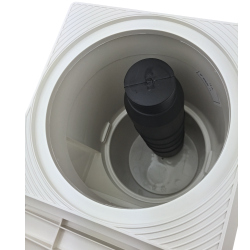
How to winterize the outdoor part of the pool?
How to drain pool pipes and prepare individual elements in the pool for winter.
Draining pool pipes for winter
When the pool technology is above the water level and all pipes are inclined toward the pool (are you sure?), simply draining the pool will also drain the pipes (water will flow from them into the pool). The problematic part here is the skimmer, from which the pipe logically goes up to the filter. Loosen the screw on the ball valve to the skimmer in the machine room; this will allow the pipe to be aerated, and the water will flow into the skimmer. The water from the skimmer then needs to be removed to keep it dry.
When the technology is in a pit or basement, I assume that the pipes are inclined towards the pit or at least one-half towards the pit and the other towards the pool. The half inclined towards the pool will be drained by draining the pool. You will drain the other half by loosening the ball valves of the individual branches in the machine room and letting the water out. Take a bucket for this; there is a lot of water in the pipes. If you know that there are air loops somewhere along the pipe route, you need to remove the water from the pipes with a compressor.
What to do with the drained skimmer?
It is advisable to cover the top part of the skimmer for the winter to prevent water from entering. Alternatively, you can use a dilatation plug for the skimmer. This prevents the skimmer from cracking if water enters and freezes. The plug also seals the outlet from the skimmer.

Winter plugs for pool jets
Draining the counter-current system
After draining the water beneath the counter-current, release and re-engage it two to three times briefly (for a few seconds). Water will squirt from the jet into the pool. Then loosen the screws on the valves in the pit, and if the counter-current pump has a drainage screw, loosen it, allowing the water to drain from the pump chamber. If there is no screw, remove the pump, pour out the water (then reinstall the pump or store it somewhere warm). The jet part of the counter-current still needs to be dried. Detach the front cover, dry everything with a cloth, and then reattach the cover.
Securing the nozzles for winter
Once the pool is drained below the nozzles and the pipes are drained, you can use winter plugs as a safeguard against water. It's not 100% necessary, but you will have the assurance that no water will enter the system.

Winter float for skimmer

Winter float for skimmer top view

Winter float for skimmer front view
Winterizing water attractions suction
Each suction has a cover, so remove it and wipe the inside of the suction dry. Then put the cover back in place.
Winterizing pool lights
Remove the front part of the light with the bulb from the chamber, dry it, and wrap it, preferably in a bag, to prevent water from entering. Leave the light pulled out and placed on the pool edge. It's a good idea to secure it with a string to the deck so that it doesn't fall into the pool.
Bottom Drain
If you have a bottom drain for the pool, it depends on its construction and the location of the equipment room.
When the equipment room is in a pit or basement
If a winter plug can be used, plug the drain outlet and loosen the screw on the valve in the equipment room to drain the water. Then tighten the screw again. Be sure not to leave it loose because if the plug at the drain ever fails, water from the pool will leak into the equipment room. This applies when the pipe from the drain is inclined towards the equipment room.
When the equipment room is above the level of the pool
In this case, it doesn't make sense to plug the drain because water from the pipe cannot be removed. The water in the pipe outside the pool will remain at the same level as the water level in the pool.
Covering the water surface for winter
Finally, cover the pool with a winter cover or a pool pillow. It is worth covering the pool for the winter. The pool surface will not be exposed to direct frost, preventing the degradation of plastic materials. If you use a pool pillow, the water beneath it will not freeze, saving you a lot of work during winterizing and spring pool startup.
